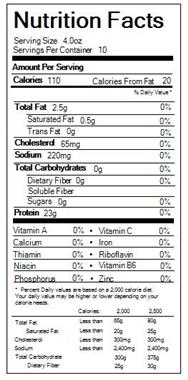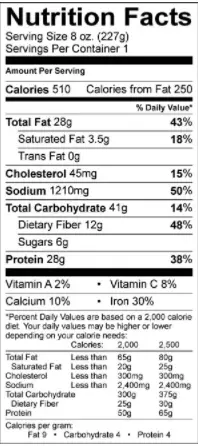

- #Chicken breast nutrition facts skin
- #Chicken breast nutrition facts full
- #Chicken breast nutrition facts free
Also, animals are fed quality feed without antibiotics or growth hormones
#Chicken breast nutrition facts free
Chickens aren’t kept in cages or crates and are free to participate in natural behaviors. This certification means that the producer meets Certified Humane standards. Here’s a breakdown of what to look for when shopping for chicken: Usually, most folks don’t know what certain labels mean, especially when it comes to animal welfare and food quality. If you’re confused by food labels, you’re not alone. It’s also a decent source of selenium, iron, and niacin.īonus: One study suggested that replacing red and processed meats with a combination of poultry, eggs, fish, and plant-based proteins could help reduce the risk of death. In addition to protein, chicken breast contains a variety of vital vitamins and minerals like B vitamins, vitamin A, and zinc. This one-two punch of animal and plant-based protein can keep you much more satiated. So, if you start to get super hungry 1 or 2 hours after eating, add a combo of chicken breast and beans to your plate.
#Chicken breast nutrition facts full
A study found that chicken breast had more amino acids and protein than other parts of cooked chicken, including the legs and wings.Īlso, protein is the most filling macronutrient and can keep you full for a long time. Your body doesn’t produce essential amino acids on its own, so you need to get them from your diet. For starters, it’s an excellent source of amino acids (aka, the building blocks of protein). Sauteing can also be healthy, but it depends on the type of oil or fat you use to cook the chicken in.Ĭhicken breast is chock full of good-for-you nutrients. Try to opt for healthier seasonings, like herbs and pepper rubs, and stick to baking or grilling. That can add up quick, fam.īut don’t worry, you can still take your chicken to Flavor Town. For example, a single fried and coated chicken wing is about 55 grams (g) and has 158 kilocalories (kcal), 11.1 g of fat, and 2.67 g of saturated fat. (Sorry not sorry, Colonel.)Īlso, sauces and seasonings can def pump up the volume on the bad-for-you vibes. So, it’s prob best to avoid or limit frying foods when you can. Studies show that consuming fried foods on the reg can increase your risk of obesity, heart disease, and certain types of cancers, including prostate. Why cooking countsĬooking methods can have a major impact on the calorie, fat, and carb content of chicken breasts.
#Chicken breast nutrition facts skin
hot dogs, margarine, pan-fried steak, and bacon) then having chicken skin here and there is completely fine. If your overall diet is low in other foods high in AGEs (e.g. Just keep in mind, it’s all about moderation. They’re known to contribute to increased oxidative stress and inflammation, which might increase your risk of certain diseases. AGEs are molecules created through reactions between sugars and proteins or fats. One thing to keep in mind is that roasted, grilled, or fried chicken skin has high levels of advanced glycation end products (AGEs).

Oh, and did we mention it tastes delish, too? Note: We’re talking about nutritious sources of saturated fat and cholesterol - like full-fat yogurt and whole eggs - not highly processed foods.Ĭhicken skin is also higher in certain nutrients, like iron, compared to skinless chicken breast. But TBH, occasionally eating healthy foods higher in saturated fat and cholesterol is not bad for your overall health. Powered by the ESHA Research Database © 2018, ESHA Research, Inc.Chicken skin gets a bad rap because it’s higher in saturated fats than skinless chicken breast.

If you are following a special diet for medical reasons, be sure to consult with your primary care provider or a registered dietitian to better understand your personal nutrition needs. (-) Information is not currently available for this nutrient. (For example, it’s recommended that people following a heart-healthy diet eat less sodium on a daily basis compared to those following a standard diet.) Depending on your calorie needs or if you have a health condition, you may need more or less of particular nutrients. Per the Food and Drug Administration (FDA), the daily value is based on a standard 2,000 calorie diet. Percent Daily Value (%DV) found on nutrition labels tells you how much a serving of a particular food or recipe contributes to each of those total recommended amounts. * Daily Values (DVs) are the recommended amounts of nutrients to consume each day. Nutrition information is calculated by a registered dietitian using an ingredient database but should be considered an estimate.


 0 kommentar(er)
0 kommentar(er)
